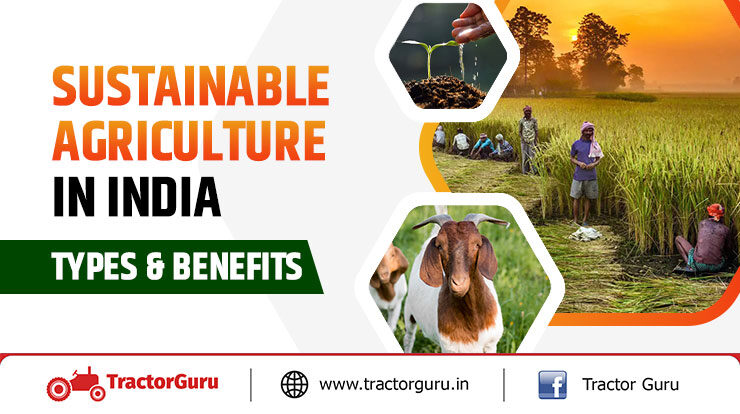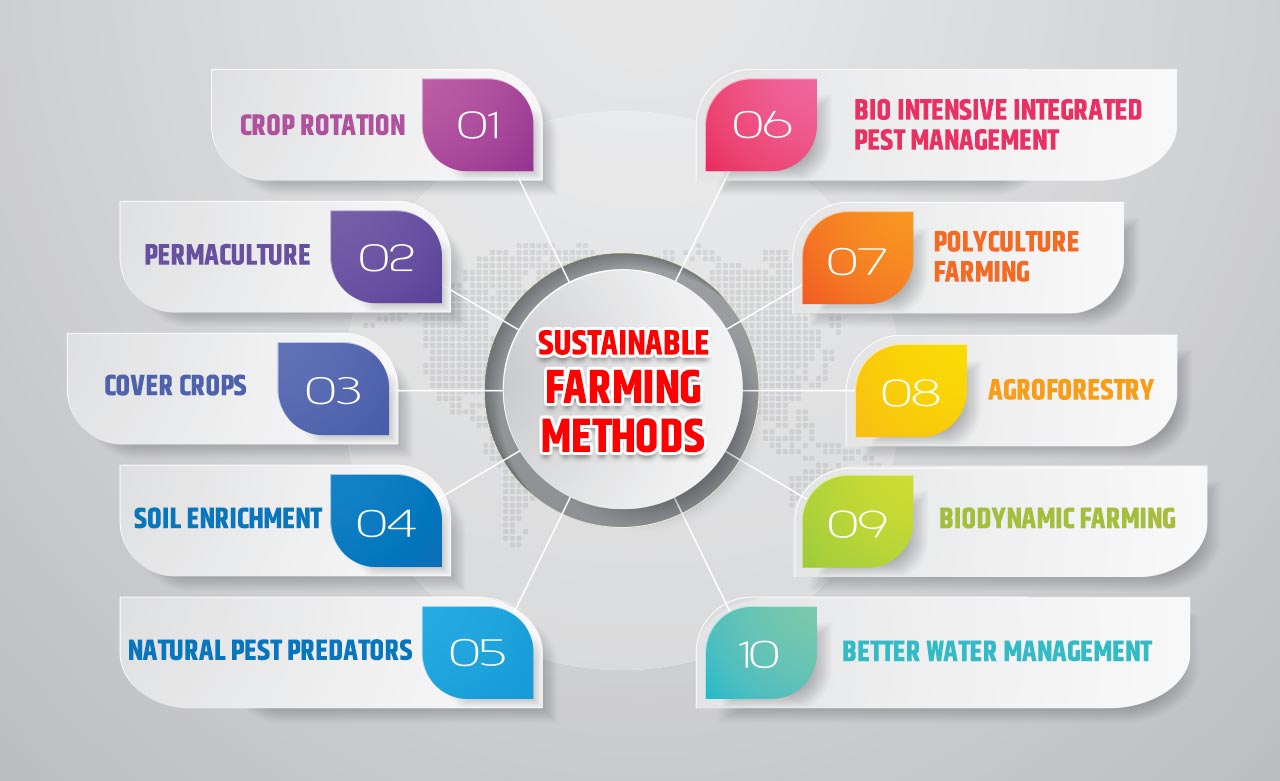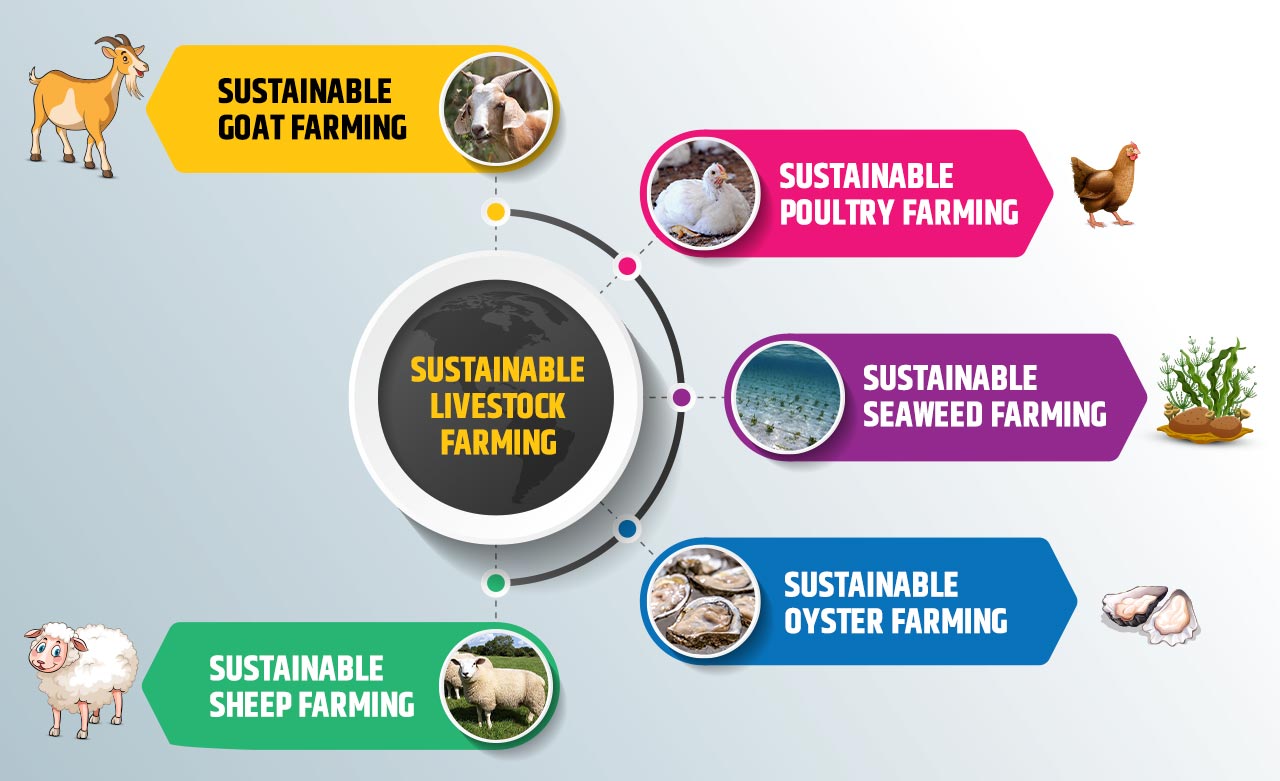Sustainable Agriculture in India – Types & Benefits

Sustainable agriculture practitioners seek to integrate three main goals into their work: a healthy environment, economic profitability, and social and economic equity. Food processors, distributors, producers, retailers, consumers and waste managers can play a role in ensuring a sustainable agricultural system. In addition, it is helpful in reducing greenhouse gas emission and conserving energy.
What is Sustainable Agriculture?
Sustainable agriculture involves the use of most preferable energy sources like hydropower, wind farms or solar power which are eco-friendly. You can use the solar panels for heating systems and also for run pumping. In addition, hydroelectric power derived from river water can be used for various agricultural machinery. In the below section you can check the proper detail about the need for sustainable agriculture methods and also can find benefits of sustainable agriculture.
Why do we need sustainable agriculture and how is it beneficial for food security?
The goal of sustainable agriculture is to end hunger, improve nutrition and also it can helpful in achieve food security. The agriculture sector plays a role in achieving the United Nations agriculture and sustainable development Goal to end hunger by 2030. In additional, this is the main objective of sustainable agriculture and food security.
Sustainable Agriculture Methods

Here below, check the methods of sustainable agriculture in detail.
1. Crop Rotation
Crop rotation is the most preferable technique of sustainable agriculture. However, its purpose is to avoid the consequences of planting the same crop in the same soil for consecutive years. This helps to combat pest problems, as many pests prefer specific crops. In addition, r3otation breaks the insect’s reproductive cycle. During rotation, farmers can plant certain crops that supplement the plant’s nutrients. Rotation breaks the reproduction cycles of pests. During rotation, farmers can plant certain crops, which replenish plant nutrients. However, these sustainable crops minimise the need for chemical fertilisers.
2. Permaculture
Permaculture is a food production system designed for smart farming to reduce waste of resources and increase production efficiency. Also, these design techniques consist of growing grain without tillage, herb and plant spirals, keyhole and mandala gardens, hooglyculture garden beds, sheet mulching, each plant serving multiple purposes.
3. Cover Crops
Many farmers choose to plant crops in one field at all times and never leave it barren; also, this may cause unintended consequences. The farmer can achieve his goals of preventing soil erosion, enhancing soil quality and also suppressing the growth of weeds through plant cover crops like clover or oats. The cover crop’s use also reduces the need for chemicals like fertilisers.
4. Soil Enrichment
Soil is a central component of the agricultural ecosystem. Good soil can help increase yields as well as produce stronger crops. It is possible to maintain and also helpful in enhance soil quality in several ways. Some examples include the release of crop residues into the field after harvest and also include the use of composted plant material or animal manure.
5. Natural Pest Predators
To maintain effective control of pests, it is a core factor to view the farm as an ecosystem instead of a factory. For example, many animals and birds are natural predators of agricultural pests. Therefore, manage your farm so that it can harbour populations of these insect predators. However, chemical insecticides can lead to the indiscriminate killing of insect predators.
6. Bio intensive Integrated Pest Management
Integrated Pest Management is an approach dependent on biological instead of chemical methods. The IMP also stresses on the importance of crop rotation to tackle pest management. Once the pest problem is identified, IPM will ensure that chemical solutions are used only as a last resort.
7. Polyculture Farming
Polyculture farming technique is similar to crop rotation which tries to follow natural principles to get the best yield. Therefore, it engages in growing multiple crop species in one region. Also, these species generally complement each other and help bring out a greater variety of products on the same plot while fully utilising the available resources. The high biodiversity makes the polyculture sustainable farming system more flexible to seasonal fluctuations..
8. Agroforestry
Agroforestry has become a strong tool for farmers in arid regions with soils prone to desertification. Also, it engaged in the growth of trees and shrubs among crops or grazing land and agriculture. And it is forestry practices for long-lasting, productive and diverse land uses when approached sustainably.
9. Biodynamic Farming
Biodynamic farming incorporates holistic and ecological growing practices based on the “anthropology” philosophy. In addition, it focuses on implementing practices like composting application of animal manure, supplementary crops or rotating cover crops. Also, these practices generate the soil fertility necessary for food production.
10. Better Water Management
The foremost step in water management is the choosing of the right crops and also local crops are selected which are suited to the weather conditions of the area. In addition, crops that do not require a lot of water should be selected for dry areas.
Benefits of Sustainable Agriculture
- contribution to environmental protection
- saves energy for the future
- public health protection
- prevents pollution
- Stop air pollution
- Stop soil erosion
- Cost Reduction
- Biodiversity
- economically beneficial for farmers
- social equality
What is Unsustainable Agriculture?
Unsustainable agriculture is the adoption of practices that ultimately lead to degradation in the quality of land, soil and other natural resources that are essential for farming and also best for a healthy future.
Sustainable Livestock Farming

Sustainability of livestock relies on practices that: Improve productivity and also input use by implementing a multi-level system for feed resources and an associated management plan. Here are some of the most profitable sustainable animal farming.
A. Sustainable Goat Farming
Raising goats can be an important part of a sustainable farm. In addition, integrating livestock into the agricultural system can enhance its economic and environmental health.
B. Sustainable Poultry Farming
The plants feed the chickens and the chickens fertilise the plants – it’s a closed, sustainable nutrient loop for sustainable chicken farming.
C. Sustainable Seaweed Farming
Compared to many other farming practices, seaweed is seen by some as the pinnacle of sustainable aquaculture.
D. Sustainable Oyster Farming
This farming has a positive impact on the environment – practically unique among any type of food. Hence, it is considered a sustainable food across the board.
E. Sustainable Sheep Farming
Sheep are raised for meat and wool. Sheep farming is basically carried out in southern India. And, also Indian sheep are not viewed as dairy sheep. So, sheep milk is consumed in very limited areas such as Rajasthan, Jammu Kashmir and Gujarat.
There are some other Sustainable Farming-
A. Sustainable Sugarcane Farming
This farming requires tweaks in order to enhance yields and sustainably meet this demand.
B. Sustainable Indoor Farming
Vertical farms and commercial greenhouses are given as examples of indoor sustainable farming. In addition, to be sustainable that needs to be supported by a low carbon power supply.
C. Intensive Sustainable Farming
This is a different pattern of food production that has the five criteria of sustainable agriculture by emphasising on modern science.
D. Sustainable Urban Farming
This farming is the production of fibre products and food in urban environments using emerging, new and traditional methods.
E. Sustainable Organic Farming
Sustainable Organic agriculture is an efficient agricultural approach for environmental sustainability as it provides yield stability and better soil health. However, Organic farming and sustainable agriculture produce ample food without depleting the earth’s resources.
F. Sustainable Rice Farming
As rice farmers are most vulnerable to climate change, the sustainable rice platform recently set the world’s first benchmark for sustainable rice.
G. Sustainable Cocoa Farming
It means that farmers have access to agricultural education and training to improve crop yields while protecting the environment.
H. Sustainable Ocean Farming
Ocean cultivation is the technique for developing fish and also other farming harvests inside a water as extensive as the ocean.
We hope this blog is vital for you, for more information regarding sustainable agricultural technologies, and also you can find any other basic inquiry about substantial agriculture, stay tuned with Tractorguru.
FAQs
Que. What are the 5 components of sustainable agriculture?
Ans. Crop management, soil management, water management, waste management and also include pest management are the 5 main components of sustainable agriculture.
Que. What is an example of sustainable agriculture?
Ans. Crop waste or animal manure is the best example of sustainable agriculture.
Que. What is an advantage of sustainable agriculture?
Ans. Nonrenewable energy, saving scarce resources, reducing chemicals, and also many more are the advantages of sustainable agriculture.
Que. What is the goal of sustainable farming?
Ans. The goal of sustainable farming is to maintain productive topsoil.
Que. What are the three pillars of sustainable agriculture?
Ans. Economic profitability, social and economic equity and also a healthy environment are the three pillars of sustainable agriculture.
Related Posts:
Hydroponic Farming



